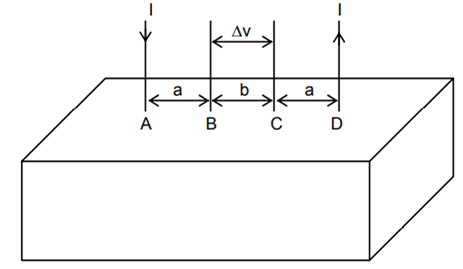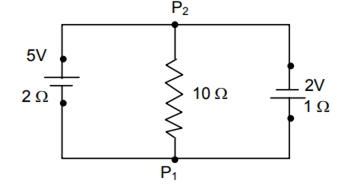 Multiple Choice Questions
Multiple Choice QuestionsConsider a block of conducting material of resistivity ‘ρ’ shown in the figure. Current ‘I’ enters at ‘A’ and leaves from ‘D’. We apply superposition principle to find voltage ‘∆V’ developed between ‘B’ and ‘C’. The calculation is done in the following steps:
(i) Take current ‘I’ entering from ‘A’ and assume it to spread over a hemispherical surface in the block.
(ii) Calculate field E(r) at distance ‘r’ from A by using Ohm’s law E = ρj, where j is the current per unit area at ‘r’.
(iii) From the ‘r’ dependence of E(r), obtain the potential V(r) at r.
(iv) Repeat (i), (ii) and (iii) for current ‘I’ leaving ‘D’ and superpose results for ‘A’ and ‘D’.
For current entering at A, the electric field at a distance ‘r’ from A is




A 5V battery with internal resistance 2Ω and a 2V battery with internal resistance 1Ω are connected to a 10Ω resistor as shown in the figure. The current in the 10 Ω resistor is 
0.27 A P2 to P1
0.03 A P1 to P2
0.03 A P2 to P1
0.03 A P2 to P1
An ideal coil of 10H is connected in series with a resistance of 5Ω and a battery of 5V. 2 seconds after the connection is made, the current flowing in amperes in the circuit is
(1-e)
e
e-1
e-1
A long straight wire of radius ‘a’ carries a steady current i. The current is uniformly distributed across its cross section. The ratio of the magnetic field at a/2 and 2 a is
1/4
4
1
1
The resistance of a wire is 5 ohm at 50°C and 6 ohm at 100°C. The resistance of the wire at 0 °C will be
2 ohm
1 ohm
4 ohm
4 ohm
The Kirchhoff’s first law (∑ i= 0) and second law (∑iR = ∑E), where the symbols have their usual meanings, are respectively based on
conservation of charge, conservation of energy
conservation of charge, conservation of momentum
conservation of energy, conservation of charge
conservation of energy, conservation of charge
A material ‘B’ has twice the specific resistance of ‘A’. A circular wire made of ‘B’ has twice the diameter of a wire made of ‘A’. Then for the two wires to have the same resistance, the ratio
2
1
1/4
1/4
In a Wheatstone’s bridge, there resistances P, Q and R connected in the three arms and the fourth arm is formed by two resistances S1 and S2 connected in parallel. The condition for bridge to be balanced will be




The resistance of a bulb filament is 100 Ω at a temperature of 100°C. If its temperature coefficient of resistance be 0.005 per °C, its resistance will become 200 Ω at a temperature of
200°C
300°C
400°C
400°C
